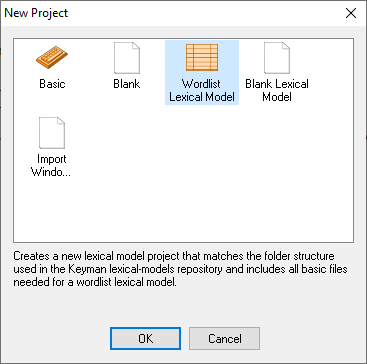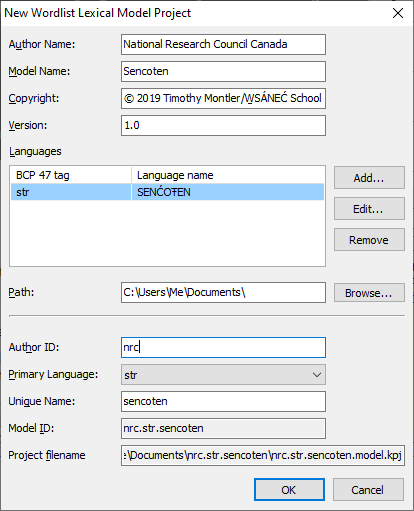Step 2: Creating a lexical model project
Create the new project
Start Keyman Developer. On the “Welcome” screen, click on New Project.... The “New Project” dialog will appear. Select “Wordlist Lexical Model” and press OK.

The “New Project” dialog, with “Wordlist Lexical Model” selected.
Provide required information

The New Lexical Model dialog box.
The “New Wordlist Lexical Model Project” dialog will appear.
To make sharing your lexical model easier, a project needs the following information:
- Author Name
- This is either your full name or the organization you're creating a model for. In this example, I am creating a lexical model on behalf of my organization, the National Research Council Canada, so I write that as the author name.
- Model Name
- We recommend the name of the language, dialect, or
community that this model is intended for. The name must be
written in all the Latin letters or Arabic numerals. In this
example, we're creating a language model for SENĆOŦEN, so we use the
model name
Sencoten.
Provide auxiliary information
The following information is also required, but most users will use default values.
- Copyright
- Who owns the rights to this model and its data? Typically, you can use the automatically generated default value: © 2024 Your Full Name or Your Organization.
- Version
- If this is the first time you've created a lexical model for you
language, you should leave the version as 1.0. Otherwise, your
version number must conform to the following rules: A version string
made of
major revision number.minor revision number.
Determine your language's BCP 47 language tag
Keyman needs to know how to link your model to the appropriate keyboard layout, so that they can both work together. To do this, Keyman utilizes BCP 47 language tags.
To add a language tag, click the Add button to bring up the “Select BCP 47 Tag” dialog box.

The “Select BCP 47 Tag” dialog box for SENĆOŦEN.
Enter the BCP 47 language tag that you have selected. Learn more about BCP 47 language tags
Once you are finished adding the primary language, click OK to return to the New Lexical Model Project dialog.
The Model ID
Keyman will create a model ID which is how Keyman sorts and organizes different lexical models. If you choose to share your model publicly, the model ID is vital for both people and Keyman to identify and use your lexical model!
Keyman automatically generates a model ID for you, given all the information already filled out. If you're satisfied with the generated model ID, you can skip to the next step.
In this example, my generated model ID is
national_research_council_canada.str.sencoten, derived from my
organization name, the name of the primary language, and my model name.
However, I find the “author ID” part of the generated model ID
excessively long. I changed the author ID to nrc, and the model ID
automatically changes to the much more manageable nrc.str.sencoten.
Double-check the information
Verify that all of the information is correct. Once all of the required information has been filled in and verified, click OK to create the project.
Once we have created the project, we can begin to prepare the data!




